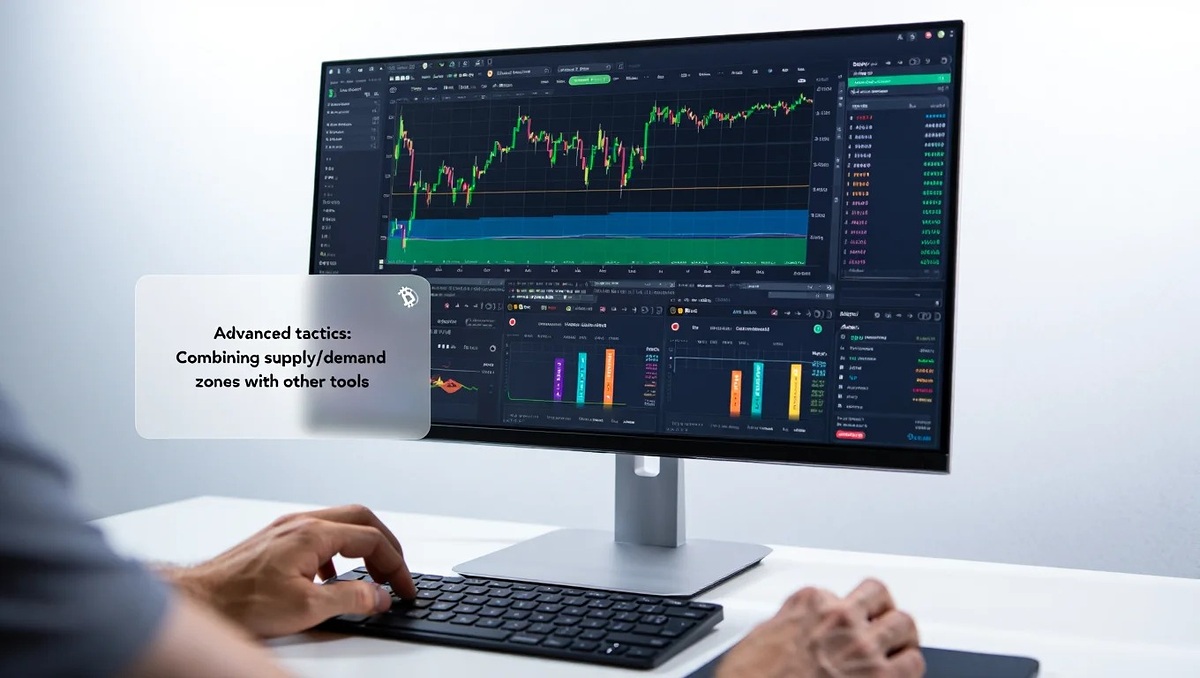How to use supply and demand zones when trading options to boost your win rate? By identifying where institutions are likely to buy or sell, you can anticipate reversals, plan better entries, and select optimal strikes.
Many traders struggle with poor timing and unreliable signals, but supply and demand zones offer a structured solution. They help remove guesswork, letting you trade with confidence using proven patterns that reflect market psychology.
In this guide, you’ll learn how to use supply and demand zones when trading options with real-world examples, strategy breakdowns, and actionable tips. Let’s dive in with Vietnam-UStrade.
1. What are supply and demand zones?
Supply and demand zones are areas on price charts where significant selling (supply) or buying (demand) happens, causing price to reverse or pause. These zones form because large traders or institutions accumulate or distribute shares, creating clusters of activity rather than single price points. On charts, you typically see these zones developing after price consolidates and then makes a sharp move away, leaving behind “wicks” or volume spikes as clues.

Key points to know about these zones:
- They represent zones, not precise lines, meaning price reacts within a range.
- Wicks or shadows on candlesticks often highlight rejection at these levels.
- Institutional involvement is a primary reason zones hold value over time.
- Breakouts and reversals often occur when price enters these areas.
As supply and demand expert Sam Seiden explains in his trading frameworks, spotting these zones helps traders anticipate where smart money steps in. For example, an annotated chart might show a clear demand zone forming after a strong bullish impulse, signaling potential support.
This foundational concept is key to understanding how to use supply and demand zones when trading options effectively.
2. How to identify high-probability supply and demand zones
To master how to use supply and demand zones when trading options, identifying high-probability zones is essential.

Follow these steps to spot strong zones:
- Use multiple timeframes: Start with daily or 4-hour charts to find major zones, then refine entries on 1-hour or 15-minute charts.
- Look for sharp price moves: Zones often show immediate price drops or surges after consolidation, with quick retracements indicating institutional activity.
- Check candle wicks: Long tail wicks pointing away from a zone suggest strong rejection.
- Notice gaps and volume spikes: High trading volume near a zone strengthens its reliability.
- Use tools cautiously: Supply/demand indicators or scanners can highlight zones but verify manually to avoid false signals.
For example, marking a recent stock’s chart reveals two clear demand zones where price sharply bounced, offering actionable insights for entry.
3. Why you should learn how to use supply and demand zones when trading options
Supply and demand zones provide more than just price levels; they offer predictive clues about possible reversals, breakouts, or trend continuations. One of the best ways to understand how to use supply and demand zones when trading options is by comparing them to traditional support/resistance levels.

| Aspect | Supply & Demand Zones | Support/Resistance Lines |
|---|---|---|
| Definition | Broader zones reflecting institutional order blocks | Single price levels based on past highs/lows |
| Predictive Power | High for reversals and breakout timing | Moderate, may be prone to false breaks |
| Options Strategy Use | Guides strike and expiration for directional and neutral plays | Used mainly for entry/exit levels |
| Flexibility | Dynamic zones adapting with price action | Fixed horizontal lines |
Using zones lets options traders better time their plays and choose strike prices aligned with expected price reactions. For instance, a trader who ignored a strong supply zone may have bought calls just before a sharp reversal, resulting in a loss. By contrast, respecting zone placement could guide them to a bear put spread instead, improving odds and managing risk more effectively.
4. How to use supply and demand zones when trading options
Learning how to use supply and demand zones when trading options starts with accurate chart analysis across multiple timeframes.

4.1 Mark zones on the underlying asset’s chart
Start with a multi-timeframe approach to pin down significant zones:
- First, identify high timeframe supply and demand zones on daily or 4-hour charts. These represent stronger, more reliable zones.
- Zoom into lower timeframes like 1-hour or 15-minute to refine zone boundaries and confirm entries.
- Focus on zones with clear, sharp price moves away, long wicks, and volume confirmation for strength.
- Filter out weak or overlapping zones to avoid confusion and false signals.
- Use charting tools that allow precise zone marking, like shaded rectangles or horizontal bands.
Precision here lays the foundation for choosing the best option trades.
4.2 Choose the right options strategy using zones
Use this decision guide to match zones with option strategies:
| Zone Type | Recommended Options Strategy | Strike & Expiration Tips |
|---|---|---|
| Demand Zone (Bullish) | Buy calls, bull call spreads | Strike close to zone; expiration aligned with expected move duration |
| Supply Zone (Bearish) | Buy puts, bear put spreads | Strike near zone resistance; time expiration to capture reversal |
| Range-bound Zones | Iron condors, butterflies, calendar spreads | Select strikes inside zone; expiration matching consolidation period |
For example, if price approaches a demand zone and shows bullish reversal cues, buying calls or bull spreads nearby can capitalize on the expected bounce. If the price breaks through the zone, prepare to adjust or roll the position accordingly.
This kind of analysis reflects the core of how to use supply and demand zones when trading options to choose the right strategy.
4.3 Plan entry, exit, and risk based on supply and demand zones
This kind of analysis reflects the core of how to use supply and demand zones when trading options to choose the right strategy.
Effective trade management anchors around zones:
- Entry: Enter trades near or just inside the zone, where price is likely to reverse or slow.
- Stops: Place stops beyond the opposite edge of the zone instead of arbitrary percentages to reflect zone validity.
- Profit-taking: Target price moves between zones or partial profit-taking as price reacts favorably.
- Consider options-specific factors: Account for volatility, time decay, and liquidity when sizing and managing positions.
| Scenario | Entry | Stop Loss | Take Profit |
|---|---|---|---|
| Price reverses at demand zone | On initial bounce | Just below demand zone | Next supply zone or partial |
| Zone breaks | Wait for confirmation before re-entry or close | Close or roll to new zone | Manage losses, avoid chase |
This approach emphasizes disciplined trades rooted in price structure, improving risk control. Use zone structure for stop-loss instead of arbitrary levels. Also, consider using stop and limit orders to fine-tune entries.
5. Advanced tactics: Combining supply/demand zones with other tools
For traders looking to refine how to use supply and demand zones when trading options, combining zones with confirmation tools can significantly improve accuracy.

Learn more : what is bitcoin trading
Enhance your zone strategy by integrating confirmation signals. Here are some common tools:
- Candlestick patterns: Look for pin bars, engulfing candles near zones signaling reversals.
- Volume analysis: Confirm zone strength with volume spikes or order flow data.
- Indicators: Use VWAP, pivot points, or RSI to support zone signals.
- Non-directional spreads: Deploy iron condors or butterflies at strong range-bound zones to profit from expected consolidation.
Caution: Avoid “front-running” zones (trading before confirmation) or assuming every zone will hold. A recent case study showed a trader combining a demand zone with a bullish engulfing candle and high volume, resulting in a successful call spread trade, demonstrating synergy between tools.
6. Risk management and trade psychology for zone-based options trading
Managing risk is critical when trading based on zones. Here’s what to keep in mind:
- Size positions according to zone reliability and your overall portfolio risk tolerance.
- Set stop losses just beyond zones rather than at fixed percentages to reflect market structure.
- If a zone fails, don’t hesitate to close or roll trades promptly. Avoid emotional doubling down.
- Be aware of biases like overconfidence in zones or hesitation at obvious levels, which can hurt execution.
What to do if a zone fails: Review confirmation signals, reassess market context, tighten stops, or exit to control losses. Emotional control is often overlooked when learning how to use supply and demand zones when trading options, but it’s vital to execution.
7. Real-world examples and case studies of options trades using supply/demand zones
These examples show not only what happened, but also illustrate how to use supply and demand zones when trading options in real scenarios.
- Trade 1: Stock XYZ approached a strong demand zone on the daily chart. The trader bought a call option with strike near the zone and expiration two weeks out. Entry came as price formed a hammer candle and volume spiked. The stock rallied 8% over one week, allowing the trader to exit with a 60% gain.
- Trade 2: A supply zone on stock ABC resisted price rallies multiple times. The trader sold a bear put spread with strikes just below this zone, anticipating a pullback. Price reversed from the zone and dropped, netting a 40% profit after partial closing mid-trade.
These examples show how combining zone analysis with proper timing and strategy selection leads to consistent edges. Key lessons include patience, confirmation seeking, and strict risk management for varying outcomes.
Further reading for curious traders:
8. Integrating supply and demand analysis into an options trading plan
To build a reliable trading plan using zones:
- Create watchlists by scanning for stocks with clear supply/demand zones using manual review or AI-based scanners.
- Journal every trade with notes on zone context, entry, exit, and results for continuous improvement.
- Backtest strategies around zones to validate and refine timing and strikes.
- Set automated alerts for when price approaches key zones to act swiftly.
This process-focused approach moves trading from guesswork to a repeatable, disciplined framework. This structured approach helps you apply how to use supply and demand zones when trading options consistently across different markets.
9. FAQs
9.1 Can supply and demand zone strategies work with weekly or monthly options?
Yes, but you must match your timeframe and volatility expectations. Longer-term options reduce decay risk but require broader zones and patience. Shorter expirations offer higher leverage but carry more noise and risk.
9.2 What’s the difference between supply/demand zones and support/resistance?
Supply and demand zones are wider price areas influenced by institutional buying or selling. Support and resistance tend to be single price lines based on past highs or lows.
9.3 What option strategies are best when price is consolidating within a zone?
- Iron condors
- Butterfly spreads
- Calendar spreads
9.4 Should you reverse your trade if a supply/demand zone breaks?
Sometimes. It depends on confirmation and overall market context. Not all breaks are true reversals; always prioritize risk management before reversing positions.
10. Conclusion
Ultimately, how to use supply and demand zones when trading options comes down to precision, discipline, and context-driven execution. This technique helps minimize risk and boost strategy efficiency, especially when combined with tools like candlestick patterns or volume indicators.
To recap:
- Identify strong zones across multiple timeframes.
- Choose strategies (calls, puts, spreads) based on zone behavior.
- Use zone structure for stop loss and take profit planning.
- Always integrate risk management and avoid assumptions.
Don’t forget to follow the Trader & Trading category on Vietnam-UStrade to stay up to date with the latest insights.
Have you used supply and demand zones in your options strategy?
We’d love to hear your experience drop a comment or question below and let’s discuss. Want more tools and tactics? Explore our trading strategy resources to level up your next move.





